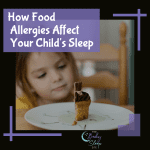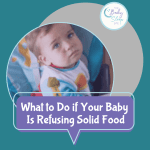 We’ve already started the discussion about food allergies and sensitivities on this blog; if you haven’t read the overview article yet, you can find it here.
We’ve already started the discussion about food allergies and sensitivities on this blog; if you haven’t read the overview article yet, you can find it here.
If you’ve read that article, you have a nice foundation of knowledge about the difference between food allergies, food sensitivities, and food intolerances. You also know a bit more about the potential causes of your baby’s food issues, as well as the likelihood that your baby will outgrow his food allergies or sensitivities.
That’s all well and good. But what about practical, useful tips to help you deal with your baby’s food allergy or sensitivity?
That’s what we’re starting today. In this article, we’ll examine the spectrum of symptoms that food sensitivities and food allergies can cause; we’ll also look at how to diagnose your baby’s food allergies and sensitivities.
NOTE: If you suspect your child has a food allergy or intolerance, please check with your pediatrician for testing and additional information.
Symptoms of Food Allergies, Food Sensitivities, and Food Intolerances
If only there were a nice, tidy set of easy-to-recognize symptoms that would help us recognize and identify our babies’ food allergies and sensitivities.
Unfortunately, there’s not!
Instead, symptoms of food allergies and sensitivities tend to span a broad spectrum. Some symptoms are easy to detect; others are subtle and easy to miss.
SYMPTOM CHART
| Body System Affected | FOOD ALLERGIES | FOOD SENSITIVITIES | FOOD INTOLERANCES |
| Skin | Skin rashes, hives, itching, eczema | Skin rashes, hives, itching, eczema | None |
| Digestion | Nausea, vomiting, stomach cramps, diarrhea | Nausea, bloating, gas, diarrhea | Nausea, vomiting, stomach cramps, bloating, gas, diarrhea |
| Airways and Lungs | Swelling of tongue, swelling of airways, shortness of breath, chest pain | None | None |
| Immunity | None | Chronic nasal congestion, chronic ear infections, suppressed immunity | None |
| Other | Anaphylaxis | “Brain Fog” (inability to concentrate), increased irritability, muscle/joint aches, headaches, fatigue, sleep disorders | None |
Notice that the symptoms of food intolerance and the symptoms of food allergies and sensitivities overlap a bit. This can make it very difficult to know whether your child has a true food allergy or sensitivity, or whether she has a basic food intolerance.
Notice, too, that the symptoms of food sensitivities are so widespread and varying — everything from vomiting to eczema to fatigue! No wonder food sensitivities can be so hard to diagnose.
How To Tell If Your Baby Has a Food Allergy or Sensitivity
Maybe your baby’s suffering from terrible diarrhea and diaper rash, and you suspect milk may be to blame. Or, perhaps your baby seems lethargic and grumpy all the time, and you’re wondering if a wheat allergy might be the cause.
But how can you know for sure? How can you tell if your child has a food allergy or sensitivity?
First, make note of this: if your baby has a violent, acute, or dangerous reaction to a food (like a sudden wheezing or shortness of breath), seek medical help immediately. Then, consult your healthcare provider about the reaction.
Most people don’t have dangerous reactions to foods, however — it’s likely your baby’s symptoms will be less severe. If this is the case, you have two options:
1. Consult with a healthcare provider.
Remember, consulting with a healthcare provider is a must if your baby’s reactions are serious.
Detecting a food allergy, sensitivity, or intolerance is not always straightforward. Unfortunately, there isn’t a single test that can tell you if your baby or toddler has a food allergy. It is now recommended to avoid the IgG Food Panel Test and seek out an allergist/immunologist to diagnose and manage any food reactions.
2. Try an elimination diet.
Skin prick and blood tests don’t always provide the whole story, however. And they can be painful and invasive (most doctors won’t even perform skin prick tests on babies and toddlers, since the test tends to be very uncomfortable.)
Many experts agree that the best way to determine if your baby has a food sensitivity is to try an elimination diet at home. It’s best if you do this under the supervision of a healthcare provider; that way, you can ensure that your baby isn’t missing out on any vital nutrients.
(Note: if your child has serious allergic reactions, don’t mess around with an elimination diet. Go straight to a healthcare provider. Elimination diets are a good idea for food sensitivities that don’t produce acute, dangerous reactions.)
Using an elimination diet at home is relatively simple:
- Eliminate the suspected trigger food from your baby’s diet for a period of time (a few weeks to a few months.)
- During this time, observe your baby’s symptoms for signs of improvement. Consider keeping a written record for your healthcare provider.
- After the period of time is over, gradually re-introduce small amounts of the trigger food back into your baby’s diet and observe his reactions.
If your baby shows no significant signs of improvement with the elimination diet, and if re-introducing the trigger food has no noticeable effects, then you can probably rule out the possibility of a food sensitivity.
However, if you notice that your baby improves during the elimination diet, then it’s likely that she has a food sensitivity. This is especially true if your baby reacts badly when you re-introduce the food. Some parents find that their babies have a strong reaction (vomiting, for example) once the trigger food has been re-introduced; this likely happens because the long break from the trigger food has made the body especially sensitive to it.
If you suspect that your baby may be allergic to several foods (for example, milk and wheat), doing an elimination diet gets a little trickier. In this case, don’t try to do an elimination diet at home; instead, ask a healthcare provider for guidance.
My Baby Has a Food Allergy/Sensitivity — Now What?
In our next two articles, we’ll be examining common food allergies and sensitivities which affect children, along with steps that parents can take to deal with their babies’ food allergies and sensitivities.
Be sure to check them out here:
Part Three: Dairy & Egg Allergies
Part Four: Wheat, Nut, & Soy Allergies
Part Five: Handling Your Baby’s Food Allergies







